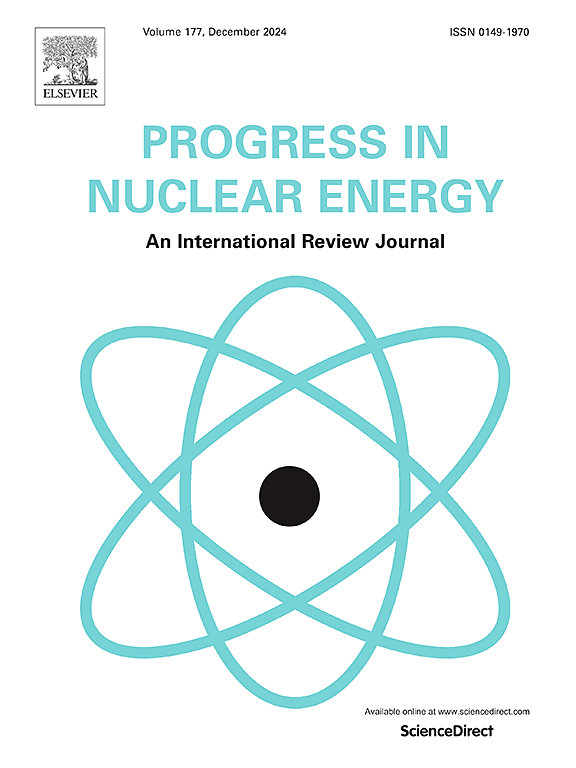球床堆燃料循环优化及燃耗分析
IF 3.2
3区 工程技术
Q1 NUCLEAR SCIENCE & TECHNOLOGY
引用次数: 0
摘要
在球床反应堆(PBR)堆芯中,成千上万个密集堆积的燃料鹅卵石缓慢向下流动。这使燃料运动复杂化,延长了燃料循环分析的计算时间。为了克服这个问题,将准静态卵石流与批量加注相结合。实现平衡核心状态需要燃耗敏感性分析,以评估耦合中子与耗尽的方法如何影响燃耗计算的准确性。数值燃耗计算面临着非线性的基本挑战:决定燃料消耗的燃耗矩阵由于依赖于中子通量而随时间变化,而中子通量本身又受核素密度分布的影响。虽然显式欧拉方法通常用于中子与燃料消耗的耦合,但其低精度在PBR应用中可能存在问题。相比之下,预测校正方法提高了精度,但需要两倍的传输计算,增加了计算需求。为了解决这些问题,本研究在HTR200设计上采用了一次通过然后出(OTTO)方案,使用SERPENT蒙特卡罗代码进行了时间步优化。通过分析有效增殖因子(k-eff)和关键同位素(如Xe-135、U-235和Pu-239),该研究突出了运行时间的显著缩短,从大约10小时缩短到大约4小时。本文章由计算机程序翻译,如有差异,请以英文原文为准。
Optimized fuel cycle and burnup analysis for pebble-bed reactors
In a pebble-bed reactor (PBR) core, hundreds of thousands of densely packed fuel pebbles flow slowly downward. This complicates fuel movement and extends computational time for fuel cycle analysis. To overcome this problem, a quasi-static pebble flow is combined with batch-wise refueling. Achieving an equilibrium core state requires a burnup sensitivity analysis to assess how methods for coupling neutronics with depletion impact the accuracy of burnup calculations. Numerical burnup calculations face a fundamental challenge of nonlinearity: the burnup matrix, which determines fuel depletion, varies over time due to its dependence on the neutron flux, which itself is influenced by the evolving nuclide density distributions. While the explicit Euler method is commonly used for coupling neutronics with fuel depletion, its low accuracy can be problematic in PBR applications. In contrast, the predictor–corrector method enhances accuracy but requires twice as many transport calculations, increasing computational demands. To address these challenges, this study performed a time-step optimization using the SERPENT Monte Carlo code on the HTR200 design under the once-through-then-out (OTTO) scheme. The study highlighted significant runtime reductions, from approximately 10 h to about 4 h, while analyzing the effective multiplication factor (k-eff) and key isotopes, such as Xe-135, U-235, and Pu-239.
求助全文
通过发布文献求助,成功后即可免费获取论文全文。
去求助
来源期刊

Progress in Nuclear Energy
工程技术-核科学技术
CiteScore
5.30
自引率
14.80%
发文量
331
审稿时长
3.5 months
期刊介绍:
Progress in Nuclear Energy is an international review journal covering all aspects of nuclear science and engineering. In keeping with the maturity of nuclear power, articles on safety, siting and environmental problems are encouraged, as are those associated with economics and fuel management. However, basic physics and engineering will remain an important aspect of the editorial policy. Articles published are either of a review nature or present new material in more depth. They are aimed at researchers and technically-oriented managers working in the nuclear energy field.
Please note the following:
1) PNE seeks high quality research papers which are medium to long in length. Short research papers should be submitted to the journal Annals in Nuclear Energy.
2) PNE reserves the right to reject papers which are based solely on routine application of computer codes used to produce reactor designs or explain existing reactor phenomena. Such papers, although worthy, are best left as laboratory reports whereas Progress in Nuclear Energy seeks papers of originality, which are archival in nature, in the fields of mathematical and experimental nuclear technology, including fission, fusion (blanket physics, radiation damage), safety, materials aspects, economics, etc.
3) Review papers, which may occasionally be invited, are particularly sought by the journal in these fields.
 求助内容:
求助内容: 应助结果提醒方式:
应助结果提醒方式:


